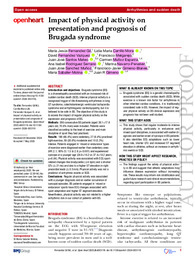Por favor, use este identificador para citar o enlazar este ítem:
https://hdl.handle.net/11000/37210Registro completo de metadatos
| Campo DC | Valor | Lengua/Idioma |
|---|---|---|
| dc.contributor.author | Fernandez Gil, María Jesús | - |
| dc.contributor.author | Carrillo Mora, Lidia María | - |
| dc.contributor.author | Fernandez Vazquez, David | - |
| dc.contributor.author | Melgarejo, Francisco | - |
| dc.contributor.author | Santos Mateo, Juan Jose | - |
| dc.contributor.author | Muñoz Esparza, Carmen | - |
| dc.contributor.author | Rodriguez Serrano, Ana Isabel | - |
| dc.contributor.author | Navarro Peñalver, Marina | - |
| dc.contributor.author | SANCHEZ MUÑOZ, JUAN JOSE | - |
| dc.contributor.author | Gimeno Blanes, Francisco Javier | - |
| dc.contributor.author | Sabater-Molina, Maria | - |
| dc.contributor.author | Gimeno Blanes, Juan | - |
| dc.contributor.other | Departamentos de la UMH::Ingeniería de Comunicaciones | es_ES |
| dc.date.accessioned | 2025-09-04T11:52:04Z | - |
| dc.date.available | 2025-09-04T11:52:04Z | - |
| dc.date.created | 2025 | - |
| dc.identifier.citation | Open Heart | es_ES |
| dc.identifier.issn | 2053-3624 | - |
| dc.identifier.uri | https://hdl.handle.net/11000/37210 | - |
| dc.description.abstract | Introduction and objectives Brugada syndrome (BS) is a channelopathy associated with an increased risk of sudden cardiac death (SCD). Intense physical activity is a recognised trigger of life-threatening rrhythmias in long QT syndrome, catecholaminergic ventricular tachycardia syndrome and arrhythmogenic cardiomyopathy, but it is believed to be safe in BS. The objective of this study is to assess the impact of regular physical activity on the expression and prognosis of BS. Methods 286 consecutive BS patients aged 39.1±17.8 years old, 70.6% men) were included. Patients were classified according to the level of exercise and main discipline of sport they had practised.Results 190 (66.4%) were sedentary, 27 (9.4%) practised light exercise, 59 (20.6%) moderate and 10 (5.3%) intense. Patients engaged in ‘mixed or endurance’ types of exercise were diagnosed earlier than sedentary ones (HR: 2.1; 95% CI: 1.5 to 2.9; p<0.001) and experienced syncope at a younger age (24.9±16.2 vs 37.4±18.2 years; p=0.04). Physical activity was associated with ECG sport-related changes like bradycardia (Δ 6 bpm) and a shorter QTc (Δ 21 ms) and also to a higher ST elevation in right precordial leads (Δ 0.5 mm). Physical activity was not a predictor of arrhythmic events or SCD. Conclusions Regular physical activity was associated with a younger diagnosis and an earlier occurrence of syncopal episodes. BS patients engaged in ‘mixed or endurance’ sports have ECG changes associated with sport adaptation and higher ST segment elevation. Nevertheless, physical activity was not related to a higher arrhythmic risk in our cohort of patients with BS. | es_ES |
| dc.format | application/pdf | es_ES |
| dc.format.extent | 8 | es_ES |
| dc.language.iso | eng | es_ES |
| dc.publisher | BMJ Group | es_ES |
| dc.rights | info:eu-repo/semantics/openAccess | es_ES |
| dc.rights | Attribution-NonCommercial-NoDerivatives 4.0 Internacional | * |
| dc.rights.uri | http://creativecommons.org/licenses/by-nc-nd/4.0/ | * |
| dc.subject.other | CDU::6 - Ciencias aplicadas::62 - Ingeniería. Tecnología | es_ES |
| dc.title | Impact of physical activity on presentation and prognosis of Brugada syndrome | es_ES |
| dc.type | info:eu-repo/semantics/article | es_ES |

Ver/Abrir:
openhrt-2024-003119.pdf
Preprint
1,22 MB
Adobe PDF
Compartir:
 La licencia se describe como: Atribución-NonComercial-NoDerivada 4.0 Internacional.
La licencia se describe como: Atribución-NonComercial-NoDerivada 4.0 Internacional.
.png)